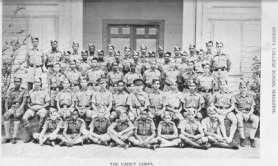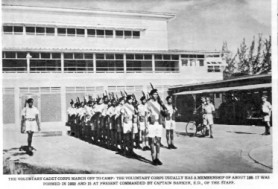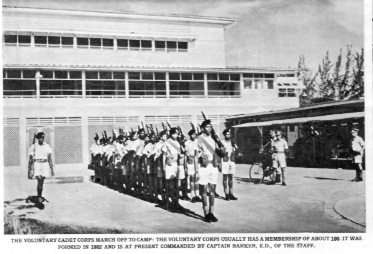Had it not been abolished in 1975, the Queen’s College Cadet Corps which was founded in 1889 would have celebrated its 120th anniversary this year. It was the first cadet corps to be established in the English-speaking Caribbean − fifteen years before that of Barbados, twenty-one before Trinidad and Tobago and fifty-four years before Jamaica. All of the other corps are still functioning and helping to train their countries’ young citizens.
By David A. Granger
Origins
The cadet corps of the Commonwealth Caribbean were patterned after the British model which was introduced in the 1860s. The British Empire in the 19th century was engaged in an incredible number of aggressive wars and expeditions in territories around the globe, literally from A to Z – from Aden, Burma, China and India to Zanzibar and Zululand and others – and was chronically short of military manpower. Local militia units, the predecessors of the Territorial Army, were organised into a countrywide Volunteer Reserve Force which formed cadet companies in public schools. Twenty years later, the practice was transplanted in British Guiana.
The Queen’s College Cadet Company, according to Norman Cameron’s History of Queen’s College, was founded in 1889 on the suggestion of Major W S Turner who was the Commanding Officer of the Volunteer Militia. The colony had no urgent need for a reserve force and both the Volunteer Militia and Cadet Company were plagued by the problems of low interest by the citizenry and low funding from the administration.

The Company nevertheless managed to maintain a programme of weekly musket drill and survived largely because the headmaster, Trevelyan Pope (1904-20), took an active interest in its administration.
The Combined Court (as the legislature of the day was called) voted $240 in 1907 to provide for uniforms and accoutrements; the Commandant of the British Guiana Militia (which replaced the Volunteer Militia in 1891) loaned belts and pouches and the Company muddled through.
European warfare gave the Company an unexpected fillip. When World War I broke out, about 100 QC old boys went off to fight; fifteen of them were killed, three winning the prestigious Military Cross.
Their sacrifice was an unforgettable inspiration and a bronze memorial plaque was unveiled in their honour in 1923. Similarly, another plaque would be unveiled after World War II. Up to the present day, it has remained part of the college tradition for the youngest student to hang a wreath of poppies between the two plaques in their honour on the last Friday before Remembrance Day in November every year.
The role of the Cadet Company in both the college and the colony was consolidated during the remarkable twenty-year principalship of Captain Howard Nobbs (1931-1951). He had seen service with the Northamptonshire Regiment in World War I and was always referred to by his military rank. He brought a strong interest in cadetship and the Company enjoyed almost uninterrupted development during his tenure.
Schoolboys joined the Company voluntarily and were able to receive progressive military training in various subjects while learning the values of citizenship, service and discipline. Although it has always been affiliated to, the Company has never been a legal branch of, the local armed forces and as such cadets were always subject to school rules and not to military law and obligations. A few cadets did go on to enlist in the volunteer and defence forces in later life but it was never the Company’s objective to recruit manpower for professional military careers.
Organisation
By the time that Queen’s College celebrated its centenary in 1944, the Company had established itself as one of the most popular students’ organisations. The cyclical rhythm of the annual academic calendar and other extra-curricular activities, nevertheless, caused its structure to be changed and its strength to fluctuate. It was also influenced by the principal’s predilections, the political situation in the country and governmental support.

Cadets in the senior school between the ages of 14 and 18 years typically stayed for the quadrennium; this meant that, each year, ranking seniors would leave and raw recruits would enter. At the outset, 48 boys enlisted and in good years, the Company’s strength could soar above 100, but had to be restricted because of financial limitations. The Company reached its highest strength of 150, about one-quarter of the student body, in September 1956 and achieved its largest enlistment of 125 recruits in September 1967. These numbers were unmanageable and had to be reduced on account of limited finance.
From the late 1930s, cadets were organised into four sections, each representing one of the four ‘houses’ of the day – Percival, Austin, Raleigh and D’Urban – but this was not sustainable as it was difficult to attract volunteers in equal numbers. The house system was abolished in 1941 and a new structure of three platoons, each commanded by a cadet officer who was a student, was introduced. This, also, was difficult to sustain. When the ‘Certificate A’ examinations were started in 1953, cadets were divided into three platoons – A, for those who had passed Part I and were being trained for Part II examinations; B, for senior cadets and C, for recruits. Typically, only two platoons – senior and junior – were maintained.
The Queen’s College administration exercised administrative and disciplinary control over the Corps and the Volunteer Militia and British Guiana Militia exercised only supervisory control during training, although operational command of the British Guiana Garrison was brought directly under the United Kingdom War Office during World War II. The British Guiana Volunteer Force replaced the militia after the war and the relationship remained; in fact, cadets started wearing the Volunteer Force cap badge in 1953 but were not formally affiliated until 1956. When the British Guiana Volunteer Force was abolished and the Guyana Defence Force was established in 1966, the Cadet Corps took up affiliation with the GDF’s 2nd battalion.
In order to preserve the collegiate identity of the corps, command was vested in a few college masters who were appointed from time to time to supervise platoons. But, at best, this was a chancy arrangement. Such officers received their commissions and, in the unique case of Captain C E Barker, the Efficiency Decoration, through the Volunteer Force. This worked well at times but the departure of masters could be disruptive. One Cadet Company Sergeant Major − Bertram Ho − thought that it was better to appoint student cadet officers rather than staff members to command platoons, writing in 1959, “The cadet officers who have come through the ranks would have a better understanding and a deeper appreciation of the problems affecting the cadet. [They] would also be more concerned about the progress of the Corps.”
Training
It was the mystique of military training, rather than the drab uniforms, dreary drill or the rigid discipline, that was the greatest attraction for the cadet. When World War II (1939-1945) broke out, an unexpected opportunity for a defence role for the Corps was realised for the first time. Cadets were divided into three functional sections – signallers, surveyors and scouts – each with its own speciality. In 1942, for instance, serious training films on the functioning of reconnaissance patrols were shown to cadets at the Astor cinema in Georgetown as part of this wartime orientation.
The long-term focus of all cadet training was the ‘Army Proficiency Certificate A’ Part I examination, which determined qualification and promotion. The examinations − Certificate A for secondary school and certificate B for universities − were designed by the British War Office for cadets and held in British Guiana for the first time in April 1953. The curriculum was conducted at the proficiency and basic levels in five core subjects − Drill and Turnout; Fieldcraft; Map reading; Marksmanship; Military knowledge; and Skill at Arms. Cadets, therefore, learnt the same skills that were taught to reserve and, later, regular soldiers enabling them to participate in operations in any terrain.
According to Laurence Clarke’s Queen’s College of Guyana: Records of a Tradition of Excellence (1844-1994), marksmanship was the most popular subject and, occasionally, some cadets were good enough to win trophies in national British Guiana Rifle Association competitions and to be selected for the colony’s teams against visiting warships. Further, by virtue of its relationship with the local forces, the Corps was accorded block membership of the British Guiana Local Forces Rifle Club and had the opportunity to practise at both the miniature and open range in Thomas Lands and to participate in its competitions.
Several prizes were awarded to encourage emulation. The most important were the ‘Hodgson Cup,’ presented by Governor Sir Frederick Hodgson in 1906 and the ‘Efficiency Shield,’ embracing all aspects of cadet training and shooting, which was introduced in 1932 and competed for annually. Several ‘spoons’ and lapel pins were awarded for marksmanship.
The highlight of cadets’ four-year career was the annual camp − a time for camaraderie, certification, competition, tough out-of-town training and, not least, promotion. The first camp was held in the precincts of the penal settlement at Mazaruni in September 1943. Another followed at McKenzie in August 1949. The following year, a camp was held at Atkinson Field (as Timehri was then called), then under US occupation, to which cadets travelled by the well-known river boat − R H Carr. In 1953, however, owing to a lack of money for transport and other out-of-town expenses, the camp was held on the college premises at Thomas Lands. The first to be held at Haywood Camp at Tacama in the Berbice Savannahs took place in April-May 1957 but, thereafter, the pattern was unpredictable on account of a series of civil emergencies in the country up to 1966.
The camp in the college compound, though not ideal, allowed tactical exercises to be held on the Georgetown Golf Club’s links nearby and shooting on the miniature range at Eve Leary and the open range at Thomas Lands, now the site of the GDF headquarters at Camp Ayanganna.
Several units of the British army came to the colony on account of the unsettled political situation and the episodic states of emergency between 1953 and 1966. That had both harmful and helpful effects on the Corps. On the one hand, British troops from time to time would contribute to training the cadets, exposing them to new weapons, techniques and tactics. Troops of the Argyll and Sutherland Highlanders, for example, instructed cadets and gave demonstrations on their ‘modern’ weapons such as Bren Gun carriers, light (2-inch) mortars, smoke grenades and parachute flares in 1954. On the other hand, there were times when the exigencies of the crisis made instructors and weapons unavailable, camps impossible and certification of cadets impractical.
An important feature of training during the school term was the ‘field day.’ This could take the form of a tactical exercise on Kelly Dam (now Carifesta Avenue) or on the grounds of the Georgetown Golf Club (now the National Park) in which blank ammunition was used. Night training was also conducted on the golf links in March 1956. Cadets were confident and proficient enough to stage a mock battle in combat gear and using blank ammunition for ‘Old Boys’ day’ in 1957.
The Corps enjoyed cordial international relations with fraternal organisations from 1939. At that time, a West Indian, inter-colonial cadet shooting competition was held which the Barbadian cadets won; the next year Queen’s won. Jamaica’s Army and Air cadet Force invited the Corps to send a representative to its 10th anniversary celebrations in 1953, and Company Sergeant Major C I C Wishart was selected to attend. But major exchanges did not begin until July 1970 with the cadet forces of Antigua and Barbuda, Canada, Guyana and Trinidad and Tobago. Four QC cadets went to Canada and six went to Trinidad while 23 came from Antigua, Canada and Trinidad to Guyana. In 1971, 38 cadets attended overseas camps in Barbados, Canada, Grenada, Jamaica and Trinidad. By 1973, cadets from ten countries were coming to Guyana. Participation in international camps continued up to the disbandment of the Corps.
Administration
There seems never to have been any legal instrument governing the administration of the Cadet Corps. Queen’s College had been incorporated by ordinance since 1848 and was empowered to make its own bye-laws and to take action in a court of law. Hence, it was clearly the principal’s responsibility to administer the Corps.
The cadets’ uniforms changed several times. According to Carl Morgan’s ‘The Story of the Cadets’ in Queen’s College Sesquicentennial Souvenir Magazine, uniforms were grey with scarlet facings and forage caps in the early days. At the outbreak of World War I, the British army changed from colourful battlefield dress to sensible khaki and, eventually, this was adopted by the Corps.
Cadets were wearing post-war supplies − peaked service caps with badges, long-sleeved tunics with patched pockets buttoned at the neck, leather belts, short pants, knee-high long puttees and leather boots, by 1938. Tunics were reserved for ‘ceremonial’ parades and the more relaxed, open-necked khaki shirts were issued for normal training in 1940. Side caps, khaki drill shirts and shorts, stockings or long puttees, leather shoes or boots, and leather accessories were then issued but these were changed again in the 1948 when post-war supplies − including forage caps and web belts − were made available.
Khaki field service caps were replaced by black berets with the Volunteer Force badge in preparation for the coronation of Queen Elizabeth II in 1953 and, in June 1956, canvas anklets replaced cloth puttees. Coloured slips to identify platoons and trousers were issued in 1957.
After independence, cadets retained their khaki uniforms but wore the green berets and badges of the Guyana Defence Force. Company Sergeant Major Richard Fields in 1957 expressed the hope that the Corps would one day be issued with “ceremonial dress” but this was never to happen.
Cadets’ ranks followed the traditional military model with the exception that warrant and commissioned officers did not exist. The ranks were Cadet Officer, Company Sergeant Major and Company Quartermaster Sergeant, Sergeant, Corporal, Lance Corporal, Senior Cadet, Cadet and Recruit. Badges of rank were those worn by the local forces.
The Corps participated in the annual round of ceremonial parades – the King’s Birthday (later, the Queen’s Birthday) and Armistice Day (later, Remembrance day). The Corps would also mount guards-of-honour for visiting dignitaries such as the Earl of Athlone in March 1950 and the ceremony for the opening of the new school in September 1951 and the visit by Governor Sir Alfred Savage in September 1953.
Clarence Trotz, in his The History of Queen’s College wrote that the Cadet Corps was “summarily abolished” in 1975 but explanation for this act is difficult to find. Recognising the value of the cadet corps, the Guyana Defence Force established the Army Cadet Company for boys from twelve Georgetown secondary schools, including Queen’s College, in February 1982.
This flourished for a few years and cadets of the Company attended camps at Tacama and Timehri. The Company, unfortunately, was transferred to the Guyana National Service to be administered as part of the National Cadet Corps and there it disappeared. An attempt was made in 1993 to resurrect the old Cadet Corps with an orientation towards expeditions and touring, but this also collapsed. Thus ended a worthwhile institution in which thousands of boys were exposed to the educational but enjoyable education of citizenship and service for over eight-and-a-half decades. The importance of the Cadet Corps was that, in its heyday, it was just one activity among a variety of voluntary sports, clubs and societies in which students could participate.
All together, according to Winston McGowan’s ‘A Concise History of Queen’s College’ in Queen’s College Sesquicentennial Souvenir Magazine, “Exposure to these activities made an invaluable physical, educational, intellectual, aesthetic, cultural, technical, moral and spiritual contribution to the lives of students at Queen’s.”

